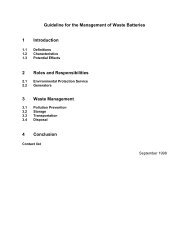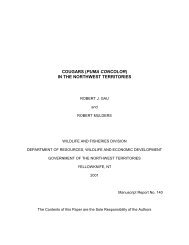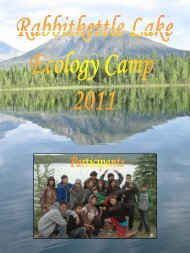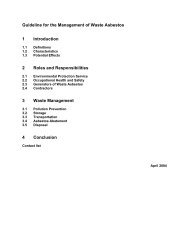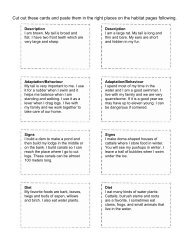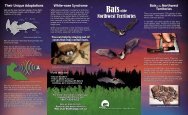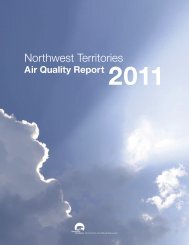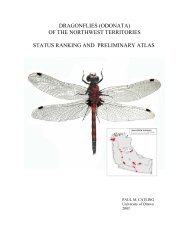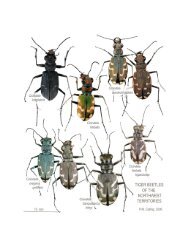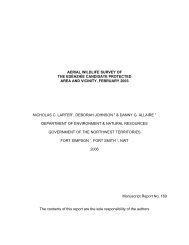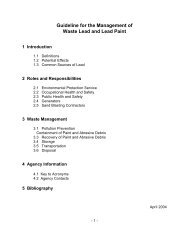Standard Operating Procedure (SOP) - Environment and Natural ...
Standard Operating Procedure (SOP) - Environment and Natural ...
Standard Operating Procedure (SOP) - Environment and Natural ...
- No tags were found...
Create successful ePaper yourself
Turn your PDF publications into a flip-book with our unique Google optimized e-Paper software.
<strong>St<strong>and</strong>ard</strong> <strong>Operating</strong> <strong>Procedure</strong> (<strong>SOP</strong>)<br />
Capture, H<strong>and</strong>ling & Release of Bears<br />
Wildlife Care Committee Primary Author: Dr. Marc Cattet Version 2 - 2011<br />
<br />
<br />
<br />
Committee (WCC) to seek assurance that investigators <strong>and</strong> personnel have<br />
the necessary training <strong>and</strong> experience to perform procedures required for the<br />
capture <strong>and</strong> h<strong>and</strong>ling of bears.<br />
Personnel administering drugs for capture or restraint must have<br />
recognized <strong>and</strong> current training in the chemical immobilization of wildlife<br />
<strong>and</strong> must use methods of drug delivery <strong>and</strong> drugs that are appropriate for<br />
bears.<br />
Current training implies that personnel have completed <strong>and</strong> passed the<br />
Canadian Association of Zoo <strong>and</strong> Wildlife Veterinarians’ wildlife chemical<br />
immobilization course, or another recognized course, within the past 5 years.<br />
Investigators should avoid capturing bears, especially pregnant bears, in<br />
the period from 4 weeks prior to den entry to the time of den emergence,<br />
October to April. Investigators should avoid capturing lactating bears <strong>and</strong><br />
their cubs-of-the-year.<br />
Bears may be particularly sensitive to capture or h<strong>and</strong>ling stress, <strong>and</strong><br />
sometimes drugs, during breeding, pregnancy, early lactation (i.e., 6<br />
months post-parturition), <strong>and</strong> in the periods immediately before <strong>and</strong> after<br />
winter dormancy (denning). Although the potential for negative effects of<br />
capture <strong>and</strong> h<strong>and</strong>ling during these times has not been adequately examined<br />
in bears, negative effects including increased loss of body mass, post-natal<br />
offspring mortality, <strong>and</strong> den ab<strong>and</strong>onment have been demonstrated in black<br />
bears (Tietje <strong>and</strong> Ruff 1980, Samson <strong>and</strong> Huot 1995), brown bears (Petram<br />
et al. 2004), <strong>and</strong> polar bears (Ramsay <strong>and</strong> Stirling 1986, Lunn et al. 2004).<br />
Further, most of the drugs used in bears are not recommended for use in<br />
pregnant or lactating animals because they have not been adequately<br />
evaluated under these conditions (e.g., Telazol [tiletamine HCl + zolazepam<br />
HCL] - Fort Dodge Laboratories, Inc.; Cervizine 300 [xylazine HCl] - Wildlife<br />
Pharmaceuticals, Inc.; Zalopine [medetomidine HCl] - Orion Corporation;<br />
<strong>and</strong> Antisedan [atipamezol HCl] – Novartis Pharmaceuticals Canada, Inc.).<br />
Capture efforts must be conducted within a pre-defined safe temperature<br />
range <strong>and</strong> procedures must be taken to prevent, or detect <strong>and</strong> treat, large<br />
changes in body temperature during h<strong>and</strong>ling or recovery.<br />
The likelihood of thermal stress (hyper- <strong>and</strong> hypothermia) can be high in<br />
some bears at certain times. A “safe” ambient temperature range for the<br />
capture of black bears <strong>and</strong> grizzly bears is from 20C to 20C <strong>and</strong> from<br />
-25⁰C to +15⁰C for the capture of polar bears. However, attention to ambient<br />
temperature alone will not be sufficient to prevent thermal stress, even if the<br />
ambient temperature is within the recommended range. Other factors<br />
including wind exposure, precipitation, method of capture, the physical<br />
exertion at capture <strong>and</strong> size <strong>and</strong> health status of the bear must also be<br />
considered. Prolonged helicopter pursuit of an adult bear in prime body<br />
condition can cause severe hyperthermia (body temperature 40C) even<br />
before the animal is safely immobilized. Similarly, a yearling bear captured<br />
by leg-hold snare <strong>and</strong> restrained for hours while exposed to inclement<br />
weather may succumb to hypothermia (body temperature 36C) before the<br />
trap site is even checked by the field crew. Measures that can be taken to<br />
4



